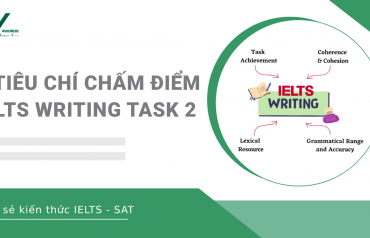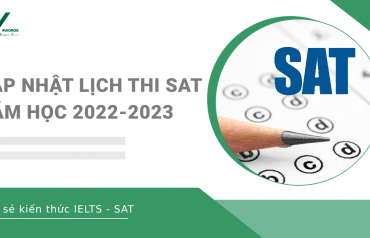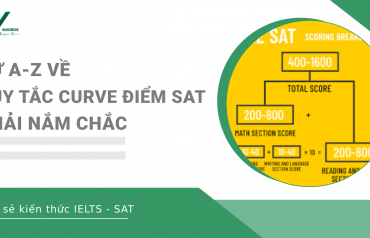Dạng bài Multiple Choice trong IELTS Reading và cách làm
Để đạt điểm IELTS xuất sắc, chúng ta cần đặt mục tiêu tối đa điểm Đọc hiểu. Phát triển kỹ năng đọc còn giúp củng cố kiến thức đã biết, mở rộng vốn hiểu biết sang các lĩnh vực đa dạng. Ngoài ra, qua mỗi một bài đọc, chúng ta sẽ chắt lọc được các cụm từ, ý tưởng hay để vận dụng trong nói -viết.
Vậy làm thế nào để xử lý bài Đọc hiểu tốt nhất? Hãy bắt đầu từ việc xác định các dạng bài thường gặp. Từ đó, xây dựng chiến thuật làm bài cụ thể nhé.

SERIES 1 – IELTS READING – DẠNG BÀI MULTIPLE CHOICE

Phương pháp làm dạng bài Multiple Choice
Trắc nghiệm là dạng bài khá phổ biến trong đề thi IELTS. Thí sinh được yêu cầu chọn một đáp án chính xác nhất trong số 3 hoặc 4 lựa chọn. Đây là dạng câu hỏi mà học sinh thường hay mắc vào bẫy thông tin. Sau đây là một số gợi ý hữu ích để xử lý dạng bài này.
● Đọc câu hỏi và gạch chân từ khóa (keywords) trong câu hỏi. Sau đó các bạn sử dụng kĩ năng quét thông tin (scanning) để tìm từ khoá trong bài. Những từ khóa này có thể được giữ nguyên. Thậm chí có thể được diễn đạt bằng những cách khác mà nghĩa không thay đổi.
● Gạch chân những từ khoá mà trong đó các từ khoá đó làm nghĩa của câu khác biệt với các lựa chọn còn lại.
● Xem xét lại các từ khóa trong mỗi lựa chọn một lần nữa khi tìm được đúng đoạn văn có đáp án.
● Đọc kĩ đoạn văn một cách cẩn thận, so sánh các lựa chọn với nhau. Sử dụng phương pháp loại trừ nếu cần thiết. Ví dụ nếu lựa chọn A đúng thì cần chứng minh được B,C,D sai. Nếu không chứng minh được B,C,D sai thì đáp án A chưa chắc chắn 100%.
Ví dụ tham khảo dạng bài Multiple Choice
Which one is correct about the experiment conducted by Ren6 Marois?
A. participants performed poorly on the listening task solely
B. volunteers press a different key on different color
C. participants need to use different fingers on the different colored object
D. they did a better job on mixed image and sound information
● Bước 1:
Định vị thông tin dựa vào các từ khóa. Từ khoá là từ không thay đổi và/hoặc từ đồng nghĩa với các danh từ, động từ, tính từ…
Which one is correct about the experiment conducted by Ren6 Marois? → Tìm các từ “Ren6 Marois” và “experiment”
The problem, according to Rene Marois, a psychologist at Vanderbilt University in Nashville, Tennessee, is that there’s a sticking point in the brain. To demonstrate this, Marois devised an experiment to locate it. Volunteers watch a screen and when a particular image appears, a red circle, say, they have to press a key with their index finger. Different colored circles require presses from different fingers. Typical response time is about half a second, and the volunteers quickly reach their peak performance. Then they learn to listen to different recordings and respond by making a specific sound. For instance, when they hear a bird chirp, they have to say “ba”; an electronic sound should elicit a “ko”, and so on. Again, no problem. A normal person can do that in about half a second, with almost no effort.
● Bước 2:
Sau khi đã xác định được vị trí thông tin, đọc kỹ các đáp án. Khớp đáp án với thông tin tìm được. Phân tích các yếu tố đúng/sai trong từng đáp án
A. participants performed poorly on the listening task solely => Sai vì không có yếu tố “poorly on listening task solely”
B. volunteers press a different key on different color => Lưu ý đây là câu bẫy. Trong câu bẫy có rất nhiều từ ngữ đồng khớp với các từ ngữ đã sử dụng trong vị trí thông tin, nhưng cách kết hợp từ khác biệt tạo ra nghĩa khác biệt. Thông tin ở đây “a different key on different color” hoàn toàn khác với “Different colored circles require presses from different fingers.”
C. participants need to use different fingers on the different colored objects. => Đúng vì câu này có cùng nghĩa với câu diễn đạt “Volunteers watch a screen and when a particular image appears, a red circle, say, they have to press a key with their index finger. Different colored circles require presses from different fingers.”
D. they did a better job on mixed image and sound information => Sai vì không có thông tin so sánh “better job” trong vị trí thông tin.
● Bước 3:
Khoanh đáp án đúng. Có thể sử dụng dấu gạch vào các yếu tố sai ở các đáp án còn lại.
● Khi làm đủ các bước phân tích như trên, các em sẽ thấy rất chắc chắn khi nhận diện câu trả lời chính xác. Multiple Choice là loại câu hỏi rất hay và ngày càng phổ biến. Hiểu và vận dụng thuần thục kỹ năng để giải quyết loại câu hỏi này nhé.
Bài thực hành dạng bài Multiple Choice
Ditching that Saintly Image
Charities, it is still widely believed, are separated from the government, staffed entirely by volunteers and spend every penny donated on the cause they support. Noble stuff, but in most cases entirely wrong. Yet these misapprehensions underpin much of the trust and goodwill behind giving. And there is concern that such outdated perceptions could blow up in charities’ faces as people begin to discover what the voluntary sector is really about.
High-profile international programmes of awareness – raising activities, such as Make Poverty History, have dragged the voluntary sector into the spotlight and shown charity workers to be as much business entrepreneurs as they are angels of mercy. But with the spotlight comes scrutiny, and unless charities present compelling cases for political campaigning, six – figure salaries and paying the expenses of celebrities, who go on demanding trips to refugee camps for nothing, they may get bitten. ‘If people become more skeptical about how charities use their donations, they will be less inclined to give money,’ says Nick Aldridge, director of strategy at the Association of Chief Executives of Voluntary Organisations (ACEVO).
A wide range of initiatives have been undertaken to secure long – term trust in the sector by explaining what charities do and publishing the figures. But it’s still difficult to give donors a complete picture because, unlike profit – driven businesses, charities can’t measure achievement purely by the bottom line.
The report Funding Success suggests this might explain some of the communication difficulties charities face. Nevertheless, it suggests there are sound reasons for trying. Many funders, it claims, regard high overheads on, for example, premises, publicity and so on, that are properly accounted for, as a sign of an efficiently run organisation, rather than a waste of resources. Detailed reporting can be an important element in efforts to increase transparency. Better information might also unlock more money by highlighting social problems, and explaining what might be done to address them.
Some charities are already taking steps in this direction. The Royal National Institute for the Deaf (RNID) introduced annual impact reporting, to tell people about the effects of its work in a broader sense than an annual report would usually allow.
Each impact report looks back at what has been achieved over the previous 12 months and also states the charity’s aims for the year ahead. Brian Lamb, director of communications at the RNID, says the sector has been complacent about transparency because of the high level of trust it enjoys. ‘We have not been good at educating the public on issues such as why we do a lot of campaigning.’ He says. ‘But the more high – profile the sector becomes, the more people will ask questions.’
Baroness Onara o’Neill, chair of the Nuffield Foundation, says building trust goes deeper than providing information. She points out that the additional reporting and accounting requirements imposed on institutions across all sectors in recent years may have made them more transparent, but it has not made them more trusted. … if we are to judge for ourselves, we need genuine communication in which we can question and observe, check and even challenge the evidence that others present. Laying out the evidence of what has been done, with all its shortcomings, may provide a rather better basis for placing – or refusing – trust than any number of glossy publications that trumpet unending success.
Not everyone thinks the public needs to be spoon – fed reams of information to maintain confidence. ‘There isn’t any evidence that there is a crisis of confidence in charities,’ says Cathy Pharaoh, research director at the Charities Aid Foundation. The facts support her claim. In a Charity Commission report published in November last year, the public awarded charities 6.3 out of 10 on trust. Pharaoh believes key donors are savvier than they portrayed. ‘There is heavy dependence on middle – class donors for charity income, and I would be amazed if they didn’t realize charities had to pay to get professional staff,’ she says.
She believes the biggest threats to trust are the kind of scandals that blighted the Scottish voluntary sector in 2003. Two high – profile charities, Breast Cancer Research (Scotland) and Moonbeams, were exposed for spending a fraction of their profits on their causes. The revelations created intensely damaging media coverage. Even charity stalwarts were shocked by how quickly the coverage snowballed as two bad stories turned into a sector – wide crisis. ‘Those two incidents caused a media frenzy as journalists took every opportunity to undermine the sector,’ says Fiona Duncan, director of external affairs at Capability Scotland. After suffering a media grilling herself, Duncan launched Giving Scotland to redress the balance.
Fourteen charities, plus the Scottish Council for Voluntary Organisations and the Institute of Fundraising Scotland, joined together to put out communications restoring confidence in charities. The Scottish Executive pledged ₤30,000 and, with donations from corporate supporters, the campaign was able to secure advertising worth ₤300,000 for a lightning two week campaign over Christmas 2003.
Two months before the campaign was launched, The Herald newspaper published a poll revealing that 52 percent of people were less likely to give because of the scandals. Giving Scotland did a similar poll in February 2004 and this time more than half of the population said they were more likely to consider giving because of the campaign. ‘We learned about strength in numbers and the importance of timing – because it was Christmas, we were able to get good coverage,’ says Duncan.
It was an effective rearguard campaign. The numerous proactive initiatives now underway across the UK give charities the chance to prevent the situation ever getting that bad again – but their success will depend on whether they are prepared to shed a saintly image and rally to the cause of creating a newer, bolder one.
Questions 01 – 07:
Choose the correct letter, A, B,C or D. Write the correct letter in boxes 27 – 33 on your answer sheet.
1. What do we learn about charities in the first paragraph?
A. People trust charities because they are approved by the government.
B. Not all the funds a charity receives go on practical aid for people.
C. Charities do not disclose their systems for fear of losing official status.
D. People who work for charities without pay are not fit for the job.
2. Why, in the writer’s view, is it hard for charities to inform the public properly?
A. They calculate success differently from other businesses.
B. They are unable to publish a true financial report.
C. The amount of resources needed changes radically year by year.
D. Donors may be disappointed if they see large profits in the accounts.
3. One of the conclusions of the report ‘Funding Success’ is that
A. charities must cut down on any unnecessary expenditure.
B. raising more money for their cause should be a charity’s main aim.
C. charities should give the public an assessment of the results of their work.
D. clarifying the reasons for administration costs would not dissuade donors.
4. Baroness O’Neill’s main recommendation is that charities should
A. follow the current government requirements on reporting.
B. encourage the public to examine and discuss the facts.
C. publicise any areas in which they have been effective.
D. make sure the figures are laid out as clearly as possible.
5. What is Cathy Pharaoh most concerned about?
A. the public’s adverse reaction to the money sent on charity personnel.
B. the effect on general donations if any charity misuses their funds.
C. the reliance of many charities on a single sector of the population.
D. the findings of a Charity Commission report on public confidence.
6. Why does Fiona Duncan think the ‘Giving Scotland’ campaign succeeded?
A. The message came over strongly because so many organisations united.
B. People did not believe the critical stories that appeared in newspapers.
C. Private donors paid for some advertising in the national press.
D. People forgot about the scandals over the Christmas holidays.
7. The writer suggests that in the future, charities
A. may well have to face a number of further scandals.
B. will need to think up some new promotional campaigns.
C. may find it hard to change the public’s perception of them.
D. will lose the public’s confidence if they modernise their image.
Đáp án
1. B:
Charities, it is still widely believed, are separated from the government, staffed entirely by volunteers and spend every penny donated on the cause they support. Noble stuff, but in most cases entirely wrong.
2. A:
But it’s still difficult to give donors a complete picture. Unlike profit – driven businesses, charities can’t measure achievement purely by the bottom line.
3. D:
Nevertheless, it [Funding Success] suggests there are sound reasons for trying [charities]. Many funders [donors], it claims, regard high overheads on. For example, premises, publicity and so on, that are properly accounted for, as a sign of an efficiently run organisation, rather than a waste of resources.
4. B:
She [Baroness O’Neill] points out … if we [public] are to judge for ourselves, we need genuine communication in which we can question and observe, check and even challenge the evidence that others present.
5. B:
‘There isn’t any evidence that there is a crisis of confidence in charities,’ says Cathy Pharaoh, research director at the Charities Aid Foundation. The facts support her claim…She believes the biggest threats to trust are the kind of scandals that blighted the Scottish voluntary sector in 2003.
6. A:
After suffering a media grilling herself, Duncan launched Giving Scotland to redress the balance. Fourteen charities, plus the Scottish Council for Voluntary Organisations and the Institute of Fundraising Scotland, joined together to put out communications restoring confidence in charities…Giving Scotland did a similar poll in February 2004 and this time more than half of the population said they were more likely to consider giving because of the campaign. (success)
7. C:
…their success will depend on whether they are prepared to shed a saintly image and rally to the cause of creating a newer, bolder one.
Nếu bạn đang tìm chọn điểm đến học tập IELTS thực sự chất lượng, tận tâm, hãy kết nối cùng 4WORDS. Tham gia Thi thử – Học thử hoàn toàn miễn phí. Cùng 4WORDS Tối đa hiệu quả – Tối thiểu thời gian – Tối giản chi phí,
4WORDS dẫn đầu về thành tích đào tạo IELTS/SAT – Điểm đến học tập chu đáo chất lượng bậc nhất:
https://4words.edu.vn/thanh-tich-hoc-vien/
Tin Liên quan
Cập nhật các chuyên ngành Đại học mới được phân loại là STEM
Trong bối cảnh giáo dục hiện đại, lĩnh vực STEM (Khoa học, Công nghệ, Kỹ thuật, và Toán học) đang chứng kiến sự mở rộng nhanh chóng. Nhiều chuyên ngành mới đang được thêm vào. Sự phát triển này...
18/03/2024Những điều cần biết về SSAT Reading (Phần 2)
Nối tiếp bài viết đầu tiên về phần thi Đọc hiểu (Reading) trong bài kiểm tra SSAT: https://4words.edu.vn/ssat-reading-tips-nhung-dieu-can-biet-ve-ssat-reading/ Cùng 4WORDS bổ sung thêm thông tin hữu ích để đạt hiệu quả điểm số tốt trong SSAT Reading nhé. ÔN...
19/06/2020Nên thi IELTS tại British Council hay IDP?
Một câu hỏi thường gặp của những bạn thi IELTS là: Thi IELTS ở BC hay IDP tốt hơn? Thi ở đâu thì điểm cao hơn? Một số người thực sự nghĩ rằng có sự khác biệt về IELTS...
30/10/20205 tips khởi động mục tiêu và lập kế hoạch học tập cho năm mới
Đánh giá lại năm cũ 2021 sắp qua, chúng ta đã làm được những gì và chưa làm được những gì? Trong năm mới 2022 bạn mong muốn trải nghiệm hay đạt được những mục tiêu học tập như...
30/12/2021Đầu tư bao nhiêu là đủ để con đi du học (Phần 1)
Với sự phát triển nhanh chóng của nền kinh tế toàn cầu, nhu cầu du học ngày càng tăng cao. Bởi đây là cơ hội mang lại những trải nghiệm vô giá. Cũng như là chìa khóa “vàng” giúp...
25/08/2020








